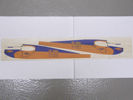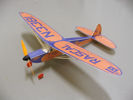Printing color and markings directly on
balsa
by Paul Bradley
When it comes to indoor and micro models, weight is everything. We all love a nice looking model, but as the size begins to shrink the finish is often sacrificed in the name of saving weight. If you happen to use balsa for your your indoor and micro creations, I have a solution to the color and markings weight problem. Thanks to the technology of computers and ink jet printers we can create some nice looking models with no weight gain. Let me say that again .... no weight gain.
This short pictorial article describes a process for printing color and markings directly on balsa using an ink jet printer. You can create your killer design and then print it right on the balsa sheets that you will be using to build the model. While your at it, you can add some color and markings to dress up the finished model. One of the best parts is the color and markings are applied before the model is even built, so you have something nice to look at while that special bird takes shape. Want to give it a try? ... I hope so.
What do you need? There are two basic requirements for printing on balsa. You first need a printer that has a straight through paper path. I use a Hewlett Packard model 1120. There are many printers that have this feature. It also helps if the printer will support banner printing. The second thing you need is some graphics software to develop your artwork. Just about any program that will let you draw will work fine. I prefer software that uses vector graphics so they can be scaled without any loss of resolution. Programs that draw using bit maps can also be used very effectively.
The process. The photos that follow will take you through the steps. Basically, the process is create your artwork and then print the balsa sheets. Here are the more detailed steps.
Please note: Some printers have toothed wheels in the paper path that help control the paper as it is printed. These wheels can sometimes interfere with the balsa and actually cut it into strips. If your printer is set up like this, it may be necessary to see if the toothed wheels can be removed. Doing so may cause later problems when printing on paper, so be sure you can live with any undesirable results from modifications you make to your printer before implementing.
 |
 |
| The finished sheet laying on the backing sheet. The same backing sheet can be used for many different parts as long as you keep the parts alignment in the same location for printing. | Here is the finished model that was developed using the described process. This is a reproduction of a 1950's kit from Top Flite called the Rascal 18. It was intended for rubber powered free flight operation. The model shown has an 18" wing span and is equipped with an M-20, 4.2:1 gear drive, single 190 mah Lithium Polymer cell, JMP Combo radio, and two Bob Selman magnetic actuators. Flying weight is 30 grams. |
In summary, it is possible to develop some very colorful and detailed models by using a computer driven ink jet printer to print directly on balsa sheets. As long as you have access to a printer that supports a straight through paper path, a little imagination, and some 1/32" or 1/20" balsa sheets you can create some very eye catching models.... with no weight penalty for the finish. If you have questions or thoughts on the process please feel free to contact me at bradleyp@ix.netcom.com